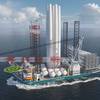AIS: Getting it Right from the Start
The Automatic Identification System (AIS) technology has received its fair share of critics up to present, mainly due to poor made installations and lack of training. The problems are currently taking the focus from the positive side where is has proven to be a most useful tool in enhancing safety and security. Lets start with going back and reminding ourselves the initial purpose with AIS as it was thought of when implemented by IMO in 1998 (IMO Performance Standard for AIS (MSC.74(69) Annex 3)).
"The AIS should improve the safety of navigation by assisting in the efficient navigation of ships, protection of the enviroment, and operation of Vessel Traffic Services (VTS), by satisfying the following functional requirements:
1. in a ship-to-ship mode for collision avoidance;
2. as a means for littoral States to obtain information about a ship and its cargo; and
3. as a VTS tool, i.e. ship-to-shore (traffic management)." These statements are clear and straight forward and should not be misinterpreted. To be able to accomplish the basic goals of the performance standard, the onboard user and operator needs to be involved in the process to secure the data transmitted. In this aspect there is a small conflict with the IMO performance standard since it states
"The AIS should be capable of: providing information automatically and continuously to a competent authority and other ships, without involvement of ship's personnel;" I believe "…without involvement of ship's personnel;" it is impossible to comply with the requirement to input the required voyage related data and checking the integrity of the AIS system, hence the need for training that IMO not yet has regulated. IMO has however issued guidelines on the use of AIS (Resolution A.917(22) Adopted on 29 November 2001; "GUIDELINES FOR THE ONBOARD OPERATIONAL USE OF SHIPBORNE AUTOMATIC IDENTIFICATION SYSTEMS (AIS)" amended A.956(23) December 5th 2003) that are quite clear and well written, but unfortunately they seem to be forgotten and not well known among mariners. It would be a good idea for manufacturers to include the operational guidelines in their own operational manuals as an appendix. They do state that: "The AIS information transmitted by a ship is of three different types:
• fixed or static information, which is entered into the AIS on installation and need only be changed if the ship changes its name or undergoes a major conversion from one ship type to another;
• dynamic information, which, apart from 'Navigational status' information, is automatically updated from the ship sensors connected to AIS; and
• voyage-related information, which might need to be manually entered and updated during the voyage.”
Further down in a table the guidelines also states that the all the different voyage related data should be manually entered at the start of the voyage and updated when required. Also the answer to the discussion of how the AIS should be activated or not can be found in the IMO operational guidelines:
"AIS should always be in operation when ships are underway or at anchor. If the master believes that the continual operation of AIS might compromise the safety or security of his/her ship or where security incidents are imminent, the AIS may be switched off. This might be the case in sea areas where pirates and armed robbers are known to operate. Actions of this nature should always be recorded in the ship's logbook together with the reason for doing so. The master should however restart the AIS as soon as the source of danger has disappeared. … In ports AIS operation should be in accordance with port requirements."
If you talk to safety and security authorities most of them believe that the AIS should remain activated in most areas of the world to enhance the surveillance capacity and the capability to distinguish abnormal behaviours thereby making protection and control easier.
Recently I had the pleasure of being onboard the Caribbean Princess on a cruise in the Caribbean. Captain Giuseppe Romano invited me to the bridge where I had a very interesting discussion about AIS with the Snr. 1st Officer Heikki Laakkonen and the 1st Officer Andrea Spinardi.
The Caribbean Princess is one of the most modern cruise ships on the market and has only been in operation since April after being delivered from Fincantieri in late March. She carries a most modern integrated bridge system that includes AIS integrated in all of the five independent radar and ECDIS workpositions. On this ship you can not even find the Minimum Keyboard and Display (MKD) on the bridge. The officer did not even know where the actual AIS unit could be found since the information from the AIS was fully part of the normal navigation system they used. The deck officers had according to my experience very good knowledge about AIS and did e.g. perform verification test and checking on their system regularly according to predefined procedures. Even so I felt that some things where missing according to the IMO guidelines that states:
"To ensure that own ship's static information is correct and up-to-date, the OOW should check the data whenever there is a reason for it. As a minimum, this should be done once per voyage or once per month, whichever is shorter. The data may be changed only on the authority of the master. The OOW should also periodically check the following dynamic information:
• positions given according to WGS 84;
• over ground; and
• sensor information." No routines existed to verify the geodetic data used by the position provided to the AIS but this is a minor problem since I believe a change to any other data than WGS 84 would quick give an indication on the general bridge system. The gyro used was a fully digital one so little risk existed, compared to older ships when transferring heading data from analogue to digital like on older ships, this was not checked but it would be obvious on other systems if errors would be occurring. The reference point of position for the AIS could not be easily accessed and verified; this was not necessarily the fault of the crew but perhaps the complexity of the Human Machine Interface (HMI). Snr. 1st Officer Laakonen, also verified what is well known: that voyage related data like ETA, destination, draft and cargo are often not available on ships that they meet. The situation is however improving. Related to the input of voyage related data he saw a great risk in the wrong use of the input of the correct navigational status that in many cases seems to be wrongly input. Further he saw also that the identity of the ships in many cases is wrong or not defined. As I explained before I believe the officers of the Caribbean Princess are a good example of how to check and verify this data regular. The bridge crew was however very positive in general about AIS and saw mostly advantages with the implementation e.g. improved situation awareness, better identification of ships making VHF contact when required less possible of mistakes. Also a discussion we had regarding future use of AIS (Class B, AtoN and AIS shore stations) was thought as encouraging and positive for the system.
Operational Aspects
Apart from the Operational guidelines for AIS that describes the need for training of and interaction by the crew as well as clear and instructions and easy to use systems from the manufacturers.
"The users must be aware that transmission of erroneous information implies a risk to other ships as well as their own. The users remain responsible for all information entered into the system and the information added by the sensors.
The accuracy of AIS information received is only as good as the accuracy of the AIS information transmitted.
The OOW should be aware that poorly configured or calibrated ship sensors (position, speed and heading sensors) might lead to incorrect information being transmitted. Incorrect information about one ship displayed on the bridge of another could be dangerously confusing.
If no sensor is installed or if the sensor (e.g. the gyro) fails to provide data, the AIS automatically transmits the "not available" data value. However, the built-in integrity check cannot validate the contents of the data processed by the AIS.
It would not be prudent for the OOW to assume that the information received from other ships is of a comparable quality and accuracy to that which might be available on own ship.
This brings us to another prerequisite about the AIS equipment in the aspect of having it to work correct both onboard and on land. Are they installed to function and operate in the correct way? IMO has as well in this aspect set forth guidelines for installation. (GUIDELINES FOR THE INSTALLATION OF A SHIPBORNE AUTOMATIC IDENTIFICATION SYSTEM (AIS); SN/Circ.227, 6 January 2003). These guidelines are unfortunately not very clear in some aspects. An extensive work is ongoing — within mainly IALA — to get the "ship's course back on track" but the fact is a majority of the installations must be done in a short time, and a large number have already been installed.
Implementing an AIS system onboard is more complex than the industry originally envisioned. Current references from installations aboard tankers and passenger ships suggests that cost savings could have been realized with better planning and implementation. The question one must ask: are you are prepared go-ahead with a poor AIS implementation and risk higher costs, when experience from classification societies and port state control exists to mitigate such expenditures.
Having been "on the other side" as a manufacturer for Automatic Identification System (AIS) for several years I can only confirm that I have seen very few professional procurements during my time as sales responsible for one of the bigger AIS manufacturers. I as well believe the owners can save plenty of time and money by using professional help from the start when fitting their ships with AIS. The AIS has been seen by many owners as yet another mandated requirement. Regardless, owners operating vessels must take into consideration a number of requirements, including first the international requirements and guidelines with many cross-references, and secondly all of the local requirements such as the Panama Canal, St. Lawrence Seaway and EU's MED (Marine Electronic Directive). The following process is an example of how to improve and reduce costs for the shipowners in the process of implementing the mandatory AIS equipment onboard their ships. From past experience, it is clearly shown that the current installations and procurements are more expensive than anticipated due to a higher complexity of the process.
The first part of the "true" process for implementing AIS onboard should be to make a study of available products on the market and a selection for preferences among these products. The next step is to take into consideration the required prerequisites for the ships on where the units are to be installed. This includes, but not limited to:
Antenna Positions
Evidentially many installations today have poorly placed antennas. During my visit onboard the Caribbean Princess the Snr. 1st Officer Heikki Laakkonen reported the different coverage on received targets from different angles. Even if the Caribbean Princess had a good coverage of about 60 NM due to its high antenna position (USCG has anticipated normal coverage of 20-30 NM for onboard use) I still believe it could have been even better since the radar did not have any problem to see 60 NM but the AIS faded at that distance. It should have been the opposite if there was a clear requirement to put the AIS antenna as high as the radar. Also to know where the GPS antennas for the AIS are placed is important.
Equipment Placing
The AIS Display equipment needs to be at the conning position if no other display system has been certified as its display system. Also where you put your AIS is for environmental reasons and to reduce the installation costs are vital factors to consider in the process.
Power Supply
The AIS has to, according to IMO installation guidelines, be connected to an emergency power source. IMO performance standard on AIS states "The AIS and associated sensors should be powered from the ship's main source of electrical energy. In addition, it should be possible to operate the AIS and associated sensors from an alternative source of electrical energy." But what does it really mean? There was an additional recommendation on this made by COMSAR 8 in February.
Interfacing Other Equipment
This is one of the most problematic issues when installing the AIS onboard. It could be interesting to know what the IMO performance standard says on the issue: "To enable a user to access, select and display the information on a separate system, the AIS should be provided with an interface conforming to an appropriate international marine interface standard.
• a means of processing data from an electronic position-fixing system which provides a resolution of one ten thousandth of a minute of arc and uses the WGS-84 datum.;
• a means to automatically input data from other sensors meeting the provisions as specified in paragraph 6.2;"
Cabling
Depending on the IMO installation guidelines, your class, the equipment manufacturer and how the IEC standard is read not all cable types are allowed to be used for installation. This could have very costly effects if you need to do it all over again, since cabling is one of the more expensive parts of the installation.
Reliability
How reliable are the different manufacturer's products not only when it comes to failure rate but also when it comes to performing according to the standards? IALA did as late as during autumn 2003 issue concerns about how AIS equipment operated in various ways when transmitting or responding to mainly Safety and Broadcast Binary Messages. I have before expressed concerns about the testing of AIS and I stress the importance of a unified test process since the AIS system is a co-operative communication system depending on the same behavior of all participants in the network.
Maintenance and Support
The quality and cost for your maintenance and support will be different from manufacturer to manufacturer. Make sure that check the capability of your supplier before you fit your ship, otherwise you will end up with extra costs that mount fast.
Approval Procedures
The approval of your equipment and installation will be according to your class and flag state procedures and these could vary, but be aware that certain minimum requirements will also probably be checked for instance during port state control inspections. Most manufacturers today have their equipment approved in Europe (EU), USA, China and some in Japan, Russia and Korea.
Training
Make sure that you have thought about how your deck officers will be trained. I do believe that even if AIS is not part of the collision regulations other than "by all means" it would be devastating in case of an accident not to have your crew trained on the AIS. Further there will also be a stronger requirement and enforcement for the ships to comply with the existing rules in a correct way. Currently training can be made through some marine universities as well as from Computer Based Training programs available on the market.
The selected provider should be contractually committed and his equipment tested before the installation process can begin. The installation should then be monitored and documented before final approval and payment. This means all the installations should be fully approved, inspected, classified and documented taking into consideration both internal and external procedures. I know that the cost for many of the initially installed AIS systems turned out to be more expensive than anticipated by the owner. But now we are facing a new category of ships with different owner groups in most cases as well as the fact that the ongoing international efforts to improve and correct the AIS standards needs to be considered. Getting help in procuring your AIS system is an investment well worth the money and would in most cases not even reach the cost for a single installation. But it is a good insurance for getting it right from the start.
The preceding was authored by Anders Bergström, a consultant at True Heading AB, a leading consulting company that provides the highest excellence and performance in the field of telematics and transponder technology. For more information on the services of the organization, visit www.trueheading.se.










